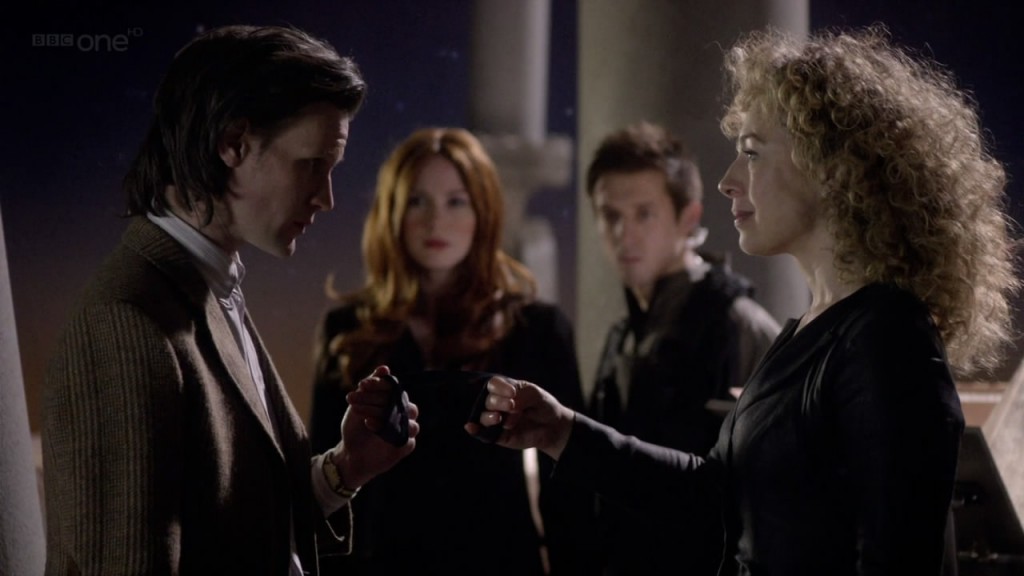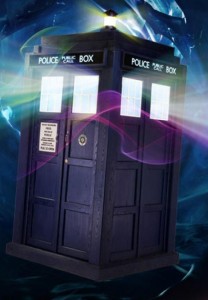Matt & the Moff: Doctor Who in Their Hands
January 3, 2014 Leave a Comment
Over in England, the third season of Sherlock has premiered, presumably resolving the cliffhanger that left our protagonist’s fate seemingly sealed. Obviously not, or there wouldn’t be a show. (Here in lowly New England, we don’t find out until January 19. And we never ever cheat.)
The show shares an executive producer, Steven Moffat, with Doctor Who. The Doctor was supposed to die twice in the past few years – really die, permanently die, not regenerate into a new face when the main actor decided to leave. One time we saw it “happen”; more recently it was foretold by that rusty old writer’s crutch, the mysterious prophesy:
On the fields of Trenzalore, at the fall of the eleventh, when no living creature can speak falsely or fail to answer, a Question will be asked, a question that must never, ever be answered.
Even more hokily, that capitalized Question was this: “Doctor who?” Because, well, we don’t know his real name. Also it’s the name of the show, get it? So, not content with the occasional wink at the camera when a new character is confused at the protagonist’s nameless title, Moffat turned the perfectly innocent, reasonable inquiry into a universe-imperiling disaster waiting to happen.
The second “death” did turn out to be Matt Smith’s exit from the series, but of course not the ultimate end. I’ll miss the guy. He brought an aggressively, purposefully nerdy and socially oblivious personality to the Doctor. When serious, he was deadly serious; when goofing off, he was pretty darn silly. Paradoxically, the youngest actor to play the role was one of the best at portraying an ancient traveler, excited to share his knowledge and even more thrilled to discover something new.
Having written some of the most popular episodes for the revived series as far back as its first season in 2005, Moffat was perhaps an obvious choice to take over. And yet, he was originally limited to one or two stories each year – quite a different schedule than guiding the overall arc and writing twice as many shows.
Early Influence
Even when he was a mere writer, characters and storylines tended to break out of Moffat’s episodes.
 His first-season “The Empty Child” and “The Doctor Dances” two-parter introduced Captain Jack Harkness, who recurred on the show for years and led his own spinoff, Torchwood. While the Harkness character was conceived by the executive producer at the time, Russell T. Davies, Moffat’s writing (and John Barrowman’s acting) doubtless had an effect on his longevity.
His first-season “The Empty Child” and “The Doctor Dances” two-parter introduced Captain Jack Harkness, who recurred on the show for years and led his own spinoff, Torchwood. While the Harkness character was conceived by the executive producer at the time, Russell T. Davies, Moffat’s writing (and John Barrowman’s acting) doubtless had an effect on his longevity.
 Moffat’s own creations, the Weeping Angels of the third season’s “Blink”, quickly became nuWho’s first breakout monster. These “quantum locked” stone creatures can only attack when not being observed, so “Don’t blink” was adopted (and inevitably way overused) as a fan catchphrase. Every subsequent appearance of the Angels naturally necessitated its breathless reiteration.
Moffat’s own creations, the Weeping Angels of the third season’s “Blink”, quickly became nuWho’s first breakout monster. These “quantum locked” stone creatures can only attack when not being observed, so “Don’t blink” was adopted (and inevitably way overused) as a fan catchphrase. Every subsequent appearance of the Angels naturally necessitated its breathless reiteration.
 In the fourth season, Moffat’s “Silence in the Library” and “Forest of the Dead” brought us the final appearance of River Song – but since this is a time travel show, it was the first of many times we would encounter her. Over the course of the next three seasons, she would become the Doctor’s assassin, resurrector, wife, and companion’s daughter. Not necessarily in that order.
In the fourth season, Moffat’s “Silence in the Library” and “Forest of the Dead” brought us the final appearance of River Song – but since this is a time travel show, it was the first of many times we would encounter her. Over the course of the next three seasons, she would become the Doctor’s assassin, resurrector, wife, and companion’s daughter. Not necessarily in that order.
Companions with Modifiers
Rather than plain old ordinary humans, Moffat’s enduring characters tended to be special in some way – a way that was suspiciously simple to describe, if only vaguely. The title of his second-season episode, “The Girl in the Fireplace”, set the naming convention.
Minutes after regenerating, Smith’s Doctor crashed his TARDIS into 11-year-old Amelia Pond’s garden. He made quite an impression on her in the few minutes they spent together; when he jaunted off in his time machine for a five-minute trip and accidentally returned seven years later, she’d built a whole imaginary identity around this “Raggedy Man”. She, therefore, became “The Girl Who Waited”, itself the title of a later episode when time trickery again separated her from the Doctor for a number of years.
Amy’s eventual husband, Rory, adopted the moniker himself. Turned into a plastic Roman warrior at Stonehenge (long story), he guarded Amy for two millennia and was dubbed “The Boy Who Waited”. His tendency to get himself killed and revived (long story) earned him the nickname “The Boy Who Dies and Dies Again” by an adversary, a member of the Silence.
After the departure of Amy and Rory from the Doctor’s life, he was joined by Clara, whom he called “The Impossible Girl” when she showed up at vastly different points in time. Some viewers might say that the concepts of these characters overwhelmed their personalities.
Attention to Legacy
When Doctor Who was revived in 2005, my impression was that it was toeing a line between being a continuation of the classic series and being a reimagining (a la Battlestar Galactica). This quantum interpretation was pretty well collapsed by the short special “Time Crash”, written by Moffat, in which the Doctor’s tenth incarnation (David Tennant) meets up with his fifth (Peter Davison).
Continuity with the classic series was hammered home a year later by Davies’ “The Next Doctor”, when a history of all the Doctor’s faces was displayed by one of his long-time foes, a Cyberman. Moffat repeated the conceit in Matt Smith’s first episode, “The Eleventh Hour”; later that season, the Doctor’s first face (William Hartnell) was shown in two separate instances as a means of identification.
As the show approached its 50th anniversary, splashing previous Doctors onscreen became even more obvious. Every face was again seen in the penultimate episode of the seventh season, Neil Gaiman’s “Nightmare in Silver”. In the Doctor’s first trip to Trenzalore one episode later, “The Name of the Doctor”, he and Clara encountered brief glimpses of his previous selves inside the timestream at his grave. And at the end of the next broadcast episode, the 50th anniversary special “The Day of the Doctor”, he posed dramatically on some kind of cloud thing overlooking his homeworld with all of his past incarnations – all but the most recent standing suspiciously still.
Time as a Thing
Perhaps Moffat’s most conscious contribution has been his transformation of Doctor Who into a true time travel show.
With rare exceptions, time travel in the classic Who series was simply a device for locating a story at a particular time and place. There were occasional shenanigans, like the fourth Doctor scribbling over Leonardo da Vinci’s canvasses to communicate with the future in “City of Death”; temporal arguments, like the fifth’s companions begging him to save one of their own after his demise in “Earthshock”; and of course multiple-Doctor stories. But for the most part, time travel was only essential to each story’s initial setting, not its plot.
Under Moffat’s reign, time and causality are important. The Doctor and River Song know each other mostly in reverse; the girl in the fireplace is a different age every time the Doctor steps through; the Weeping Angels send victims back in time, where they spend the rest of their lives unless they can cleverly insert portions of conversations into DVD special features, the content of which they only know because they have a transcript of those conversations from after they happen in the future.
Season six’s central storyline involves the Doctor’s companions witnessing his death at 1,103 years of age, followed shortly thereafter by his arrival 200 years younger. Amy Pond’s final episode features an autobiographical book written by her in the past, which the Doctor refuses to read on the grounds that as long as he doesn’t know what happens, he can still change it. The 50th anniversary special involves multiple time jumps, the rewriting of a pivotal moment between the classic and revived series, and a gathering of Doctors and TARDISes from dozens of points in history. Causes and effects routinely happen way out of order.
And Yet…
With such intricate plotting and events careening back and forth between centuries, plot holes are bound to pop up. The whole “or fail to answer” part of the Trenzalore prophesy? Forgotten. The subconscious influence of aliens over all of human history which has somehow gone unnoticed thus far in the longest-running science fiction show on television? Utterly nonsensical. All of nuWho taking place “after” the Time War, which by definition kind of doesn’t have a beginning or end? Mystifying.
In fact, just trying to figure out which stories have ended up actually happening since Moffat took over is a perhaps impossible challenge. The last episodes of seasons five and six each took place in radically alternate universes, and their resolutions hit reset buttons that may or may not have erased history. The eleventh Doctor’s regeneration in the 2013 Christmas special seems to contradict the discovery of his final resting place just two episodes earlier. Sometimes fate is unavoidable; sometimes there’s a sneaky way around it; and sometimes it can just change. Whether that’s mind-blowing or simply frustrating is a matter of opinion and temperament.
Personally, I’ve found Matt Smith the best thing about the Steven Moffat era of Doctor Who. (Okay, maybe his nifty 7/4 action music.) Even in goofier moments, there’s a gravity to his expression and a genuine sensitivity behind his alienness. Social graces may baffle him, but emotion he understands. The simple, human episode “Vincent and the Doctor”, in which even a peek at his art’s immortality fails to save Vincent van Gogh from himself, remains my favorite. How about you?








